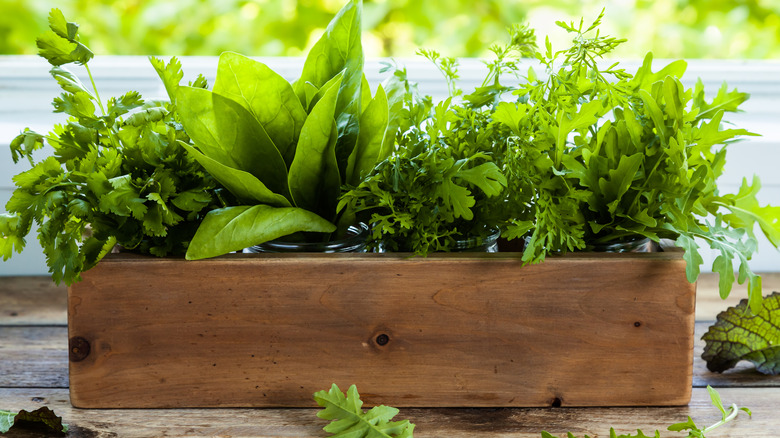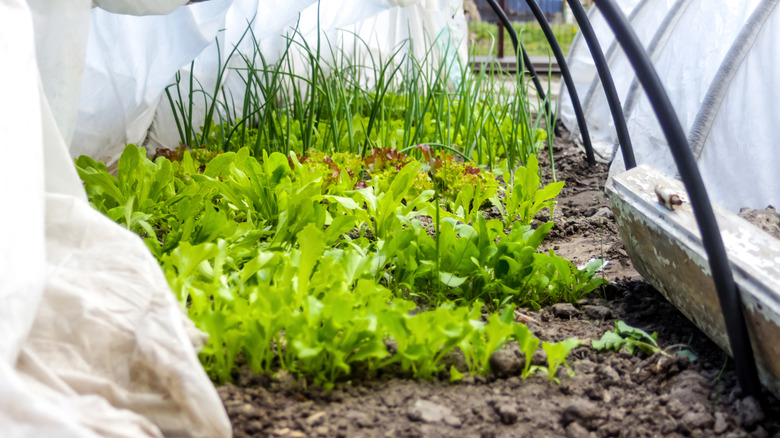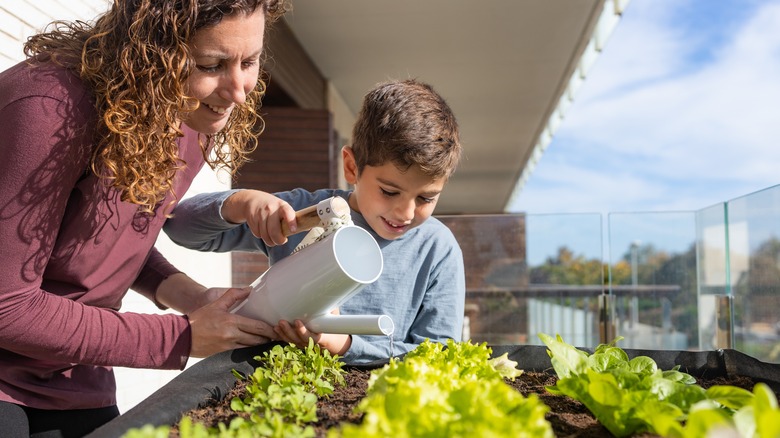The Benefits Of Planting Spinach And Arugula Side By Side
The old adage of what grows together goes together is an excellent descriptor of spinach and arugula. You'll often find the sweet flavor of raw spinach serving as a counter to the peppery bite of fresh arugula, and it's that same cohesive balance you'll get when planting them together in your garden. While both are cool-weather plants, arugula is particularly sensitive to warmer weather. If you plant spinach next to it, the plant will serve as a weather protectant, providing the heat-intolerant arugula enough shade to survive minor temperature spikes during the growing seasons of spring and fall.
A spinach plant will typically grow to a height of 8 to 12 inches, and arugula will extend upwards of about 6 to 12 inches. Clearly, that's not much of a height difference, but it's really the size of the leaf that determines the shade cover. Arugula is enjoyed best when the leaves are harvested young at just a couple of inches; older, longer leaves tend to be more bitter. Meanwhile, when harvesting spinach leaves, you should allow them to grow to a length of about 6 inches.
Growing and harvesting garden greens
Before you start sticking spinach and arugula seeds into the dirt, there are a few things to note about growing your own. Both of these plants prefer cooler weather, so plan to plant either in early spring or early fall when the soil temperature is between 50 and 60 degrees. If you're worried about a cold snap, don't be. The two plants will grow just fine if the soil drops as low as 40 degrees. Speaking of the soil, spinach and arugula have similar preferences in pH level. The sweet spot is between 6.5 and 7.
These garden greens are shallow-rooted plants that only need a couple of inches between each other on the row. You can sow directly in the ground or above it in a raised bed or container. Just be sure the soil stays moist and provide some shade if possible. When it comes time for harvest, clip the young leaves of arugula while letting spinach leaves grow to a length of about 4 to 6 inches. When you can, leave the top part of the spinach plant whole, so it can continue to provide shade to the arugula leaves below it.
Friends and foes of spinach and arugula
When planting arugula and spinach side by side, you'll want to be aware of their respective companion plants, as well as the plants neither one prefers to be near. Those lists are fairly similar, though there can be some key differences. Strawberries, for example, grow well with spinach but the bright fruit tends to take over arugula's growing area.
On the companion side of things, you have vegetables that are often used alongside our two greens: lettuce, carrots, and radishes. The two former options serve as shade extenders for the arugula while warding off disease and deterring pests for the spinach. Radish is another great pest deterrent for spinach and for arugula. This plant helps lure away flea beetles and leaf miners, two of the most destructive pests to our leafy greens. Plan to plant any of those three options near your spinach and arugula as helpful growing friends.
As for common foes, tomatoes and peppers tend to be unkind to both plants but for different reasons. For arugula, it's all about the soil. Tomatoes and peppers love a good acidic soil, but arugula doesn't thrive as well when the acid is too high. If you try to meet in the middle, you'll likely end up with a poor crop across the board. Spinach, meanwhile, tends to get attacked by similar pests as tomatoes and peppers. Avoid both to give your spinach and arugula plants the best chance of a good harvest.


